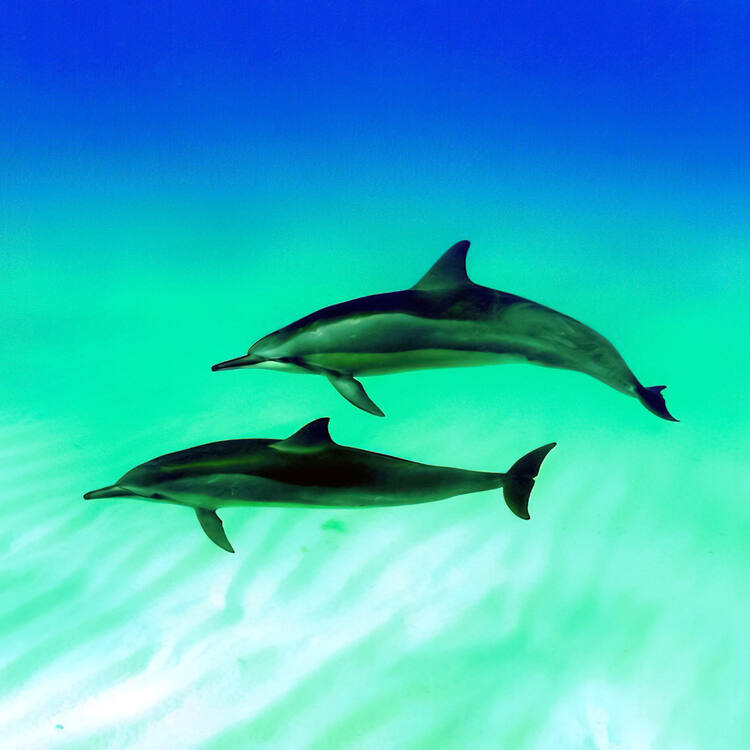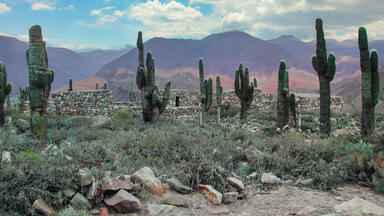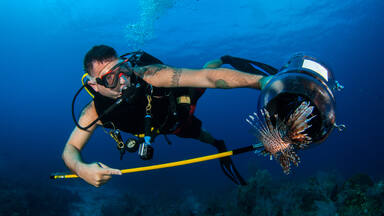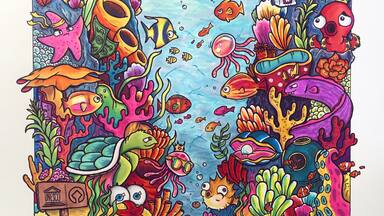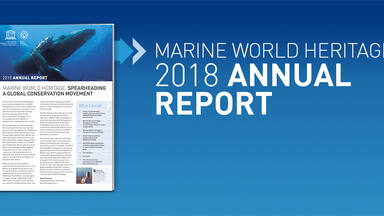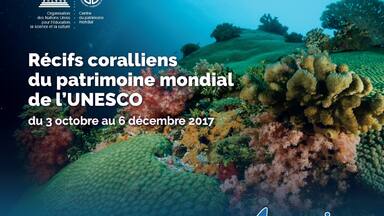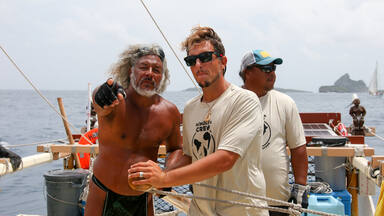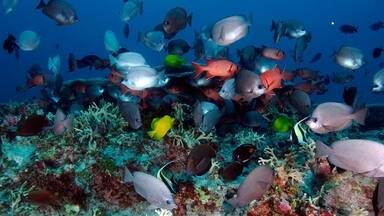Papahānaumokuākea
Papahānaumokuākea
Papahānaumokuākea is a vast and isolated linear cluster of small, low lying islands and atolls, with their surrounding ocean, roughly 250 km to the northwest of the main Hawaiian Archipelago and extending over some 1931 km. The area has deep cosmological and traditional significance for living Native Hawaiian culture, as an ancestral environment, as an embodiment of the Hawaiian concept of kinship between people and the natural world, and as the place where it is believed that life originates and to where the spirits return after death. On two of the islands, Nihoa and Makumanamana, there are archaeological remains relating to pre-European settlement and use. Much of the monument is made up of pelagic and deepwater habitats, with notable features such as seamounts and submerged banks, extensive coral reefs and lagoons. It is one of the largest marine protected areas (MPAs) in the world.
Description is available under license CC-BY-SA IGO 3.0
Papahānaumokuākea
Papahānaumokuākea est le nom d'un vaste groupe linéaire et isolé de petites îles et atolls à faible altitude (océan autour compris) situées à près de 250 km au nord-ouest du principal archipel hawaiien et qui s'étendent sur environ 1931 km. Le site possède une signification cosmologique pour les natifs hawaiiens, en tant qu'environnement ancestral, incarnation du concept de parenté entre les hommes et le monde naturel, berceau de la vie et terre d'accueil des esprits après la mort. Sur deux des îles, Nihoa et Makumanamana, on trouve des vestiges archéologiques relatifs au peuplement et à l'occupation des sols à l'époque pré-européenne. C'est aussi une zone d'habitats pélagiques et d'eaux profondes avec des caractéristiques remarquables telles que des monts sous-marins et des bancs submergés, de vastes récifs coralliens et des lagons. Il s'agit de l'une des aires marines protégées les plus vastes du monde.
Description is available under license CC-BY-SA IGO 3.0
باباهاناوْموكواكيا، في هاواي
إن باباهاناوْموكواكيا هو اسم لمجموعة من الجزر الصغيرة والجزر المرجانية ذات الارتفاع المنخفض تمتد على مساحة 250 كيلومتراً تقريباً شمال غرب الأرخبيل الرئيسي في هاواي. ويتسم الموقع بأهمية كونية بالنسبة إلى أبناء هاواي، إذ أنه يُجسّد مفهوم القرابة بين البشر والعالم الطبيعي، الذي يُعتبر مهد الحياة وملاذاً للأرواح بعد الموت. وتوجد في جزيرتين من هذه الجزر، هما جزيرة نيهوا وجزيرة ماكومانامانا، آثار تتعلق بإعمار أراضٍ وشغلها في العصر ما قبل الأوروبي. كما أن هذه المجموعة من الجزر تشكل منطقة لمواطن منتشرة في أعماق البحار ومياه عميقة ذات خصائص متميزة مثل الجبال البحرية والشطوط المغمورة والشُعب المرجانية والبحيرات الشاطئية الواسعة. وهذه المنطقة هي من أوسع المناطق البحرية المحمية في العالم.
source: UNESCO/CPE
Description is available under license CC-BY-SA IGO 3.0
帕帕哈瑙莫夸基亚国家海洋保护区
帕帕哈瑙莫夸基亚(Papahānaumokuākea)由一群线性排列的低海拔小岛和环礁及其附近海域组成,位于夏威夷主群岛以西约250公里处,跨度超过1931公里。对现存的夏威夷原住民文化来说,该遗址作为祖先生存的环境,深含着宇宙精髓与传统意义,它体现了夏威夷人概念中的人类与自然世界的亲缘关系。这里是生命的摇篮,也是死后魂灵回归之所。在遗址中的尼豪岛(Nihoa)与马库马纳马纳岛(Makumanamana)上,人们还发现了欧洲殖民前的人类定居点及其功用的考古遗迹。此外,帕帕哈瑙莫夸基亚主要由远洋和深海生物的栖息地所组成,其中包括海底山脉和海底沙滩、广阔的珊瑚礁和大面积的泻湖等。它是世界上最大的海洋保护区之一。
source: UNESCO/CPE
Description is available under license CC-BY-SA IGO 3.0
Национальный морской парк «Папаханаумокуакеа»
«Папаханаумокуакеа» (Papahānaumokuākea) - это обширная и изолированная группа небольших низменных островов и атоллов, окруженных океаном и разбросанных на протяжении почти 250 км к северо-западу от главного архипелага Гавайских островов и протяженностью около 1931 км. Для коренных гавайцев этот объект имеет космологическое значение как воплощение концепции родства между человеком и миром природы, колыбели жизни и пристанища человеческих душ после смерти. На двух островах Нихоа и Макуманамана найдены археологические свидетельства проживания людей, занимавшихся там земледелием еще до прихода европейцев. Здесь также находятся районы обитания пелагических и глубоководных организмов, отличающиеся разнообразным рельефом: здесь есть подводные горы и подводные банки, обширные коралловые рифы и лагуны. Это – крупнейший в мире охраняемый морской заповедник.
source: UNESCO/CPE
Description is available under license CC-BY-SA IGO 3.0
Papahānaumokuākea
Papahānaumokuākea es un sitio formado por un conjunto de isletas y atolones de escasa altura y el océano que los rodea. Situado a unos 250 km al noroeste del archipiélago principal de las islas Hawái, se extiende por una superficie de 1931 km. Para los hawaianos, este sitio tiene un significado cosmológico, ya que encarna el vínculo de parentesco entre los hombres y la naturaleza, cuna de la vida y tierra de albergue de los espíritus después de la muerte. Dos de sus islas, Nihoa y Makumanamana, poseen vestigios arqueológicos que atestiguan la presencia de asentamientos humanos y la ocupación del suelo antes de la llegada de los europeos. Las isletas y atolones poseen hábitats pelágicos de aguas profundas y otros elementos notables como montañas submarinas, bancos de arena sumergidos, vastos arrecifes coralinos y lagunas marinas. Papahānaumokuākea es una de las áreas marinas protegidas más vastas del mundo.
source: UNESCO/CPE
Description is available under license CC-BY-SA IGO 3.0
パパハナウモクアケア
パパハナウモクアケアはハワイ諸島から北西約250㎞に位置し、海抜の低い小さな島々と環礁群が1931㎞もの長さに連なる、広大で隔絶された海洋保護地域である。人と自然が密接に関わるというハワイ先住民文化にとって、命が生まれ死後に魂が帰る場所と考えられており、現存するハワイ先住民文化の精神的な世界観や伝統にのっとった極めて重要な場所でもある。なかでもニホアとモクマナマナの2島には、ヨーロッパ人が到来する以前の住居などの考古遺跡が残っている。海洋には広大なサンゴ環礁、深海には海山や海中に沈んだかつての島など、特徴的な地形が見られ、多様な生物が生息している。source: NFUAJ
Papahānaumokuākea
Papahānaumokuākea is een uitgestrekt en geïsoleerd lineair cluster van kleine, laaggelegen eilanden en atollen, met daaromheen de oceaan. Het gebied ligt ongeveer 250 kilometer ten noordwesten van de belangrijkste Hawaïaanse archipel en strekt zich uit over ongeveer 1.931 kilometer. De plek is van groot kosmologisch en traditioneel belang voor de inheemse Hawaïaanse cultuur. Het is een voorouderlijke omgeving door de verwantschap tussen mens en natuur en men gelooft dat het de plek is waar leven ontstaat en geesten terugkeren na de dood. Op twee van de eilanden, Nihoa en Makumanamana, zijn archeologische vondsten gedaan die betrekking hebben op pre-Europese nederzetting en gewoonten.
Source: unesco.nl
Outstanding Universal Value
Brief synthesis
Papahānaumokuākea is the name given to a vast and isolated linear cluster of small, low lying islands and atolls, with their surrounding ocean, extending some 1,931 kilometres to the north west of the main Hawaiian Archipelago, located in the north-central Pacific Ocean. The property comprises the Papahānaumokuākea Marine National Monument, which extends almost 2000 km from southeast to northwest.
The property includes a significant portion of the Hawai’i-Emperor hotspot trail, constituting an outstanding example of island hotspot progression. Much of the property is made up of pelagic and deepwater habitats, with notable features such as seamounts and submerged banks, extensive coral reefs, lagoons and 14 km2 emergent lands distributed between a number of eroded high islands, pinnacles, atoll islands and cays. With a total area of around 362,075 km2 it is one of the largest marine protected areas in the world. The geomorphological history and isolation of the archipelago have led to the development of an extraordinary range of habitats and features, including an extremely high degree of endemism. Largely as a result of its isolation, marine ecosystems and ecological processes are virtually intact, leading to exceptional biomass accumulated in large apex predators. Island environments have, however, been altered through human use, and although some change is irreversible there are also examples of successful restoration. The area is host to numerous endangered or threatened species, both terrestrial and marine, some of which depend solely on Papahānaumokuākea for their survival.
The pristine natural heritage of the area has deep cosmological and traditional significance for living Native Hawaiian culture, as an ancestral environment, as an embodiment of the Hawaiian concept of kinship between people and the natural world, and as the place where it is believed that life originates and where the spirits return to after death.
On two of the islands, Nihoa and Makumanamana, there are archaeological remains relating to pre-European settlement and use, including a large ensemble of shrines, heiau, of a type specific to Papahānaumokuākea, but which resemble those of inland Tahiti. These, together with the sites of stone figures that show a strong relationship to similar carvings in the Marquesas, can be said to contribute to an understanding of Hawaiians strong cultural affiliation with Tahiti and the Marquesas.
Criterion (iii): The well preserved heiau shrines on Nihoa and Mokumanamana, and their associated still living traditions are both distinctive to Hawai’i but, positioned within a wider 3,000 year old Pacific/Polynesian marae-ahu cultural continuum, they can be seen as an exceptional testimony to the strong cultural affiliation between Hawai’i, Tahiti and the Marquesas, resulting from long periods of migration.
Criterion (vi): The vibrant and persistent beliefs associated with Papahānaumokuākea are of outstanding significance as a key element in Pacific socio-cultural evolutionary patterns of beliefs and provide a profound understanding of the key roles that ancient marae-ahu, such as those found in Raiatea, the ‘centre’ of Polynesia, once fulfilled. These living traditions of the Hawaiians that celebrate the natural abundance of Papahānaumokuākea and its association with sacred realms of life and death, are directly and tangibly associated with the heiau shrines of Nihoa and Mokumanamana and the pristine islands beyond to the north-west.
Criterion (viii): The property provides an illustrating example of island hotspot progression, formed as a result of a relatively stationary hotspot and stable tectonic plate movement. Comprising a major portion of the world’s longest and oldest volcanic chain, the scale, distinctness and linearity of the manifestation of these geological processes in Papahānaumokuākea are unrivalled and have shaped our understanding of plate tectonics and hotspots. The geological values of the property are directly connected to the values in Hawai’i Volcanoes National Park and World Heritage property and jointly present a very significant testimony of hotspot volcanism.
Criterion (ix): The large area of the property encompasses a multitude of habitats, ranging from 4,600 m below sea level to 275 m above sea level, including abyssal areas, seamounts and submerged banks, coral reefs, shallow lagoons, littoral shores, dunes, dry grasslands and shrublands and a hypersaline lake. The size of the archipelago, its biogeographic isolation as well as the distance between islands and atolls has led to distinct and varied habitat types and species assemblages. Papahānaumokuākea constitutes a remarkable example of ongoing evolutionary and bio-geographical processes, as illustrated by its exceptional ecosystems, speciation from single ancestral species, species assemblages and very high degree of marine and terrestrial endemism. For example, a quarter of the nearly 7,000 presently known marine species in the area are endemic. Over a fifth of the fish species are unique to the archipelago while coral species endemism is over 40%. As many species and habitats remain to be studied in detail these numbers are likely to rise. Because of its isolation, scale and high degree of protection the property provides an unrivalled example of reef ecosystems which are still dominated by top predators such as sharks, a feature lost from most other island environments due to human activity.
Criterion (x): The terrestrial and marine habitats of Papahānaumokuākea are crucial for the survival of many endangered or vulnerable species the distributions of which are highly or entirely restricted to the area. This includes the critically endangered Hawaiian Monk Seal, four endemic bird species (Laysan Duck, Laysan Finch, Nihoa Finch and Nihoa Millerbird, and six species of endangered plants such as the Fan Palm. Papahānaumokuākea is a vital feeding, nesting, and nursery habitat for many other species, including seabirds, sea turtles and cetaceans. With 5.5 million sea birds nesting in the monument every year and 14 million residing in it seasonally it is collectively the largest tropical seabird rookery in the world, and includes 99% of the world’s Laysan Albatross (vulnerable) and 98% of the world’s Black-footed Albatross (endangered). Despite relatively low species diversity compared to many other coral reef environments, the property is thus of very high in situ biodiversity conservation value.
Integrity
The boundaries of the property are all located in the ocean, but nevertheless have been clearly defined, demarcated on navigational charts and communicated widely. The large size of the property ensures inclusion of a wide variety of habitat types, including a highly significant area of marginal reef environment as well as submerged banks and deepwater habitat. It also ensures a high degree of replication of habitat type. Although past use has altered some terrestrial environments the property is still predominantly in a natural state: its nature conservation status is exceptional. This is largely due to its isolation as well as a combination of management and protection efforts, some dating back more than 100 years, including national natural resource protection legislation as well as internationally adopted restrictions. The integrity of the property and its ecological processes are in excess of most other island archipelagos and most other tropical marine environments in the world.
All the cultural attributes that reflect Outstanding Universal Value are within the boundaries of the property. The archaeological sites remain relatively undisturbed by cultural factors. Although none of the attributes are under severe threat, some of the archaeological sites need further conservation and protection against damage from plants and wildlife.
Authenticity
The unique arrangement of the collections of shrines of Mokumanamana and Nihoa islands need to be read in detail for their sacred and religious associations, linked to other similar sites across the Pacific. The strong spiritual religious associations of Mokumanamana island are living and relevant. Damage due to natural processes of decay, and disturbance by wildlife could also disturb their layout and ability to display clearly their meaning.
Papahānaumokuākea is a highly protected area established through Presidential Proclamation in 2009, which adds to pre-existing state, federal and international legal mandates. The multiple layers of Federal and State legislation and regulation protect Papahānaumokuākea’s natural heritage and also its cultural heritage: both monuments and landscape. The property was declared a Marine National Monument under the national Antiquities Act, and is further protected by other national legislation including as the National Historic Protection Act, Historic Sites Act, and the Archaeological Resources Protection Act. There are also traditional Native Hawaiian protocols protecting the property’s physical and intangible cultural heritage.
The multiple jurisdictions have created a complex institutional environment for management of the property, but management planning and intervention practices are appropriate. The three management Agencies for the property are the US Fish and Wildlife Service, National Oceanic and Atmospheric Administration and the State of Hawaii Department of Land and Natural Resources. There is a need to establish and maintain effective natural, archaeological and cultural heritage skills in managing the property. An archaeologist/cultural heritage specialist is required for the property, to complement the management of its natural values. The multiple jurisdictions have created a complex institutional environment for management of the property, but management planning and intervention practices are well conceived. In view of the threats facing the property, well-governed multi-agency involvement and participation is a strength, provided the complexity does not compromise operational capacities and the ability to quickly respond to challenges. It is a particular strength in relation to addressing the threats to the property that originate beyond its boundaries.
A Monument Protection Plan has been drawn up by key stakeholders, which will act as the guiding document for the property over the next 15 years. This includes strategic objectives and detailed thematic action plans that address priority needs. It is important that these efforts are sustained with the aim to increase streamlining, including to achieve more effective mechanisms for stakeholder participation and outreach. There is a need to ensure that the management system achieves effective, equitable and integrated management that protects and conserves both the cultural attributes and natural features of the property that are the basis for its Outstanding Universal Value.
Threats to the natural values of the property emanating outside its boundaries include marine litter, hazardous cargo, future exploration and mining, military operations, Illegal, Unregulated and Unreported (IUU) fishing, commercial fishing, anchor damage, vessel strikes and Invasive Alien Species.
A key issue in relation to threats to cultural attributes is the need to ensure archaeological sites are not disturbed by burrowing animals or plants, and that monitoring indicators address the impact of natural processes on the archaeological resources. There is also a need for management to be underpinned by clear documentation of the physical cultural resource, based on the outcomes of the current archaeological investigations.

